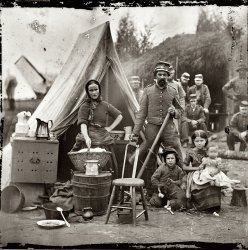
MAY CONTAIN NUTS

Search Shorpy
SHORPY ART

Framed or unframed, desk size to sofa size, printed by us in Arizona and Alabama since 2007. Explore now.
Join and Share
Ad-Free Shorpy
Shorpy is funded by you. Patreon contributors get an ad-free experience.
Learn more.

Recent comments
- Complicated then, forgotten now
- Bryan-Stevenson
- Skinny is as skinny does
- How do you rest in peace
- Riding the footboards
- Alas, hidden from view
- Baldwin Diesels
- Exclusive pump
- Bananas, Oysters and Smokey Joe
- Details, Details
- What's that building to the left of the tower?
- Coal Barges
- Bromo-Seltzer
- Inner harbor
- The Basin
- What a headache!
- Giant stepladder?
- Yeah, it was cold
- Love those coats
- Link & Pin Days Remnant
- Baldwin 62303
- Baldwin VO-1000
- Cold
- No expense spared
- Tough Guys
- What's your hurry, where's your hat?
- Sheriff's Signature
- Relocated in the Eighties
- Lost in Toyland
- And without gloves
Member Photos
The Shorpy
Print Emporium
Print Emporium
Search Shorpy
Search results -- 30 results per page
- 428 San Francisco Portland 275
- ... before opening season. View full size. Photograph by Dorothea Lange. What city is this? [Answer: Grants Pass ]
SFO-PDX I ... Posted by Dave - 08/08/2012 - 8:14pm -
![428 San Francisco Portland 275 U.S. 99 in Josephine County, Oregon. August 1939. Sign in service station window advertising for hop pickers three weeks before opening season. View full size. Photograph by Dorothea Lange. What city is this? [Answer: Grants Pass]
SFO-PDXI believe in the Full-Size I can make out the words "City of Grants Pass" on the base of the street lamp. This would make sense as 99 (not a US highway anymore) passes through the city and the mileage makes sense.
Grants PassBingo. It says BUILT BY GRANTS PASS IRON AND STEEL. Good work!
I agree with the commenterI agree with the commenter below. I can't read the lightpost base, but it's about 70 miles to Roseburg and 30 miles to Medford from Grants Pass, and I-5 was built along the old Highway 99 in that part of the state. The Portland distance is probably less right, since I-5 and 99 split north of Eugene.
The San Francisco route probably took the old HIghway 101 down the coast rather than 99, which would explain the extra mileage I didn't expect. The inland route ought to be 375-385 miles, not the 435 miles the sign says. Highway 135, which connects Grants Pass to Crescent City, would've been pretty new then.
Chet EideFor what it's worth, a death records search shows a Charles Eide born in 1920 and died 2001 in Lebanon, Oregon. Which is not far from the old Route 99. Up near Corvallis. Maybe the son of Chet?
Definitely Grants PassThe movie poster says "Rogue" and a quick Google search shows the Rogue Theatre is still a going concern in Grants Pass.
Another clue... would be the sign that says GRANTS PASS BAKERY. Doy. (Not legible in the full size jpeg but I should have looked a little closer at the hi-res tiff.)
Grants PassI should have read through the other comments before I started digging for info. :)
Grants PassOur son just emailed this link to me. The City Market in the picture was owned by my Grandfather. My Uncle that worked there is still living. He is an active 97 year old that refuses to grow old. If someone goes to the Wayside Inn at Alamo Lake, Arizona, he has many stories of the Grants Pass area, life in general, and a "few" biased opinions. I can still recall playing in the building during the early 1950's, while my Dad worked there.
Lebanon and CorvallisLebanon is well east of old hwy 99E, almost to the foothills of the Cascades. Corvallis is on the west side of the Willamette valley on old hwy 99W
HighwaysIt is Hwy 199 the connects Grants Pass with Crescent City California. I've driven it many times. The mileage is probably as near correct as any of the mileage signs in those days. The freeways shortened travel considerably. During WWII the highway over Mt. Sexton, just north of Grants Pass was rebuilt, almost to today's freeway standards because the army convoys couldn't handle the hairpin curves. I think the same thing happened to the Siskiyou pass. Prior to the freeway the highway passed through 32 towns between Portland and Medford using old 99E, a few less if you went 99W.
Prior to construction of 505 in California you had to go clear into Sacramento to get to San Francisco. I've driven all of these highways many times.
Tarzan Movie Poster in WindowFor those interested in such things:
http://www.imdb.com/title/tt0032007/
Grants PassThis is Sixth Street looking down G Street. All the shops still have businesses in them. The structure on the right is not there anymore. That corner has a small building for the Grants Pass Chamber of Commerce.
(The Gallery, Dorothea Lange, On the Road)](https://www.shorpy.com/files/images/8b34278u.thumbnail.jpg)
- Drugstore Farmboy: 1939
- ... quite Lana Turner at Schwab's, even if the photographer is Dorothea Lange. Hey kid, your 15 minutes starts right ... now. View full size.
... Posted by Dave - 06/03/2015 - 8:21pm -
![Drugstore Farmboy: 1939 August 1939. "Medford, Oregon. Half-grown farm boy on main drugstore corner in town." Not quite Lana Turner at Schwab's, even if the photographer is Dorothea Lange. Hey kid, your 15 minutes starts right ... now. View full size.
Oregon VersionOf the Texas drugstore cowboy.
Crying out for colorization.Here's another picture crying out for colorization. Hope to see it happen.
She was a "Bad Woman"Because the radio announcer was "That Way."
Screen GuideWith Joan Bennett on the cover, 29 years old at the time. Her big role that year was in The Man in the Iron Mask as Princess Maria Theresa. Her two great roles were yet to come, in Fritz Lang's The Woman in the Window (1944) and Scarlet Street (1945), starring in both with Edward G. Robinson.
Glow in the DarkThe alarm clocks with the black outer rim and white numbers are probably glow in the dark radium-painted numbers.
Use them to test your geiger counter.
Corner of Main & CentralYoung's Cut Rate Drugs, building is still there but redone.
.89 cents for a thermos.Where did we go wrong?
[89 cents, not .89 cents, which would be less than a penny. - Dave]
Like the Old Folks Used to Say ...His socks ought to throw party and invite his pants down
Give me Velvet1939 advert
Strange as It SeemsA syndicated cartoon strip from 1928 to 1970, at its peak in 1,300 newspapers. Other incarnations included books, radio shows and film shorts. Created by John Hix (1907-1944) who considered Strange as It Seems to be a library of “the curious, in nature and humankind, set adrift on the vast sea of public opinion with the hope that it will fulfill its mission to entertain and acquaint its viewers with some of the marvels of the world in which we live.”
Popular MechanicsSeptember 1939 issue.
Photoplay, September 1939With Shirley Temple on the cover.
Young's DrugsYoung's was one of a succession of drug stores in Medford's Palmer-Medynski Building, which was built by neither Palmer nor Medynski, but by Byers & Jacobs in 1884. It's among Medford's three oldest buildings--one of three known 1884 buildings to survive.
Dorothea Lange took several pictures in Jackson County, Oregon in August 1939, including two of this young man. Should you want to go to the files of the Library of Congress to find out more about them, don't bother--they have the prints, but no notes. The Farm Services Agency only retained notes and other supporting documentation when their photographers were on assignment, and Lange apparently took her Medford and other Jackson County photos "for fun," on her route in 1939 between the hop fields of Josephine County and the potato fields of Klamath County.
It's possible notes or memoirs about her Jackson County sojourn survive in her personal papers, at the Oakland Museum of California.
(The Gallery, Dorothea Lange, Stores & Markets)](https://www.shorpy.com/files/images/SHORPY-8b34619a.thumbnail.jpg)
- Ola Baby: 1939
- ... Scanned from a 4x5 inch nitrate negative photographed by Dorothea Lange.
Paring Knife Is that a paring knife on the step leading into the ... Posted by Dave - 07/30/2012 - 2:42pm -
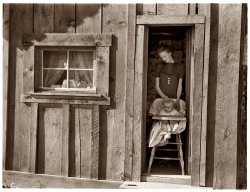
- Seven Loaves: 1939
- ... which would be only "erdy" without it. Photo by Dorothea Lange, Resettlement Administration. View full size.
A pleasant scene ... Posted by Dave - 04/12/2017 - 1:44pm -
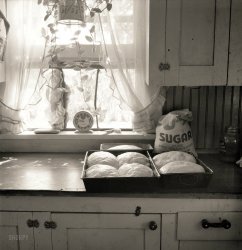
- Slum Kids: 1940
- ... His pictures lack the sometimes self-conscious drama of Dorothea Lange. They are plain, less artful, and often concentrate on the landscapes of ... Posted by Dave - 09/01/2010 - 3:04am -
![Slum Kids: 1940 April 1940. Dubuque, Iowa. "Children who live in the slums." 35mm nitrate negative by John Vachon for the Farm Security Administration. View full size.
DumbstruckI made the dumb mistake of looking at it full view. What a haunting photo.
Learn something new every dayI didn't know that little Sandy Duncan grew up in Dubuque.
What are they doing now?They do look a bit sad ... I wonder what they did of their lives, and what they are up to now. They must be about 65 years old now.
[They'd be at least 75. - Dave]
Haunting meFor some reason their face expressions haunt me after studying them for about 20 or more minutes. I am approaching 70 years on this planet now and even after all those years my heart can and does go out to them. My hope is that first comment "Entitlement- - " came true for them. They look like they deserve it.
Poor kidsNice patch job on the boy's pants. Even though they are quite young they understand the meaning of poverty. It is etched upon their faces.
Tugs at the HeartSomething about this photo makes me want to grab and hug them, and tell them everything is going to be alright.
HeartbreakingI don't have any other words. This picture really affected me. There is no excuse for the suffering of children. The clothes, the girl's eye, the dirt. I wonder what became of these kids. What life did they lead.
EyesThe girl has "lazy eye"? Easily corrected in the young, but not in adults, according to the Net.
Doh!I love Shorpy and view it every day in the hope and anticipation that I'll get to see some old school photos of my lovely home town. Maybe of the tragically destroyed Union Park, or our historic and recently renovated Shot Tower, or even the downtown bustling with shoppers and beautiful architecture. Oh well, I guess I'll have to make due with a couple of sad slum kids. :D
Growing up poorWhen you grow up poor, there is nothing anyone can do to you that life itself hasn't already done. Trust me.
HeartacheAren't they precious? I want to scoop them up and hug them. Oh, how I hope they went on to have long, happy, bountiful lives.
Inspiration They look like the inspiration for those "Sad-Eyed Kids" paintings.
The thing about kidsis that unless someone TELLS them they are deprived and that their lives are terrible, they often don't live their lives that way.
I'm not trying to romanticize the life of the poor but as long as they are loved and can play and enjoy their friends, they are usually perfectly happy. The minute they are treated as "different," that other people should look down on them, that they aren't equal to their friends, that's when they learn to hate themselves.
No entitlement mentality here!They were born in the mid-30's and are poor here, but they will be part of the small generation of young adults in the mid-1950's and enjoy America's great Postwar economic boom. They'll get a good education in the schools of the day, most likely better than those of today, and be able to get employment for life. Life after World War II will just get better and better for them and compensate for their poverty as children. They're in their 70's now and I hope comfortably retired with lots of grandchildren and great-grandchildren who love them.
John VachonI had never known about Vachon's photographs until seeing them on Shorpy, but I am starting to believe he's one of the great photographers of his generation. It's incredible that he had no art, design or photography training before starting with the FSA as a filing clerk and messenger. It's easy to see why Roy Stryker said Vachon was the FSA's "congenital photographer." He had amazing and innate talent and artistic insight, as this image clearly shows.
[He also took a bazillion pictures. Quite a few of this pair, shown below in happier times. Like 30 seconds later. - Dave]
What happened to them? Victrolajazz is right about the opportunities these kids had as they got older. For better or worse, however, their early upbringing was probably never forgotten. My aunt, slightly older than these two, carried the memories of poverty in the Depression all of her life. Even as a well-to-do senior citizen she would always buy the winter coat that cost less, no matter what she preferred. I sometimes think that that feeling of "the wolf at the door" was a better one for our country.
Depression BabiesA friend and I were born in 1930. He thinks the 1930s were the best time for this country. As I recall the decade, life was good for those who had jobs. The father of a boyhood friend was a handyman at the streetcar hq. Over time he made enough to buy a new house and a new car. He took the family every summer on a long trip. His wife did not work. They were frugal. They went to church about three times per week. The church actually was just a basement, the rest unfinished. The 1930s featured a lot of unfinished buildings. Scientific studies show that church is good for people in many ways.
Geez, what's wrong with a little dirt?They've already proven that letting kids get dirty gives them a little resistance to things like polio and asthma.
Except for the lazy eye, I could have sat right next to those kids at that age and fit into the pictures. Those kids ran and jumped and played all day. They did not sit in a room holding a little box staring at it all day. They caught bugs, made swords and knives with sticks and the little boy probably dropped a frog down his sister's back a time or two.
I feel sorrier for kids today than I do for these beautifully shaped kids.
It's not that her left eye is lazy,It's that her right eye is an overachiever!
John VachonJohn Vachon was, in my opinion, the best of all the FSA photographers. His pictures lack the sometimes self-conscious drama of Dorothea Lange. They are plain, less artful, and often concentrate on the landscapes of towns and cities, instead of people. For that reason, his work is perhaps the most valuable collection we have of what the uncelebrated and unnoticed parts of America looked like during this era.
OK, Dave, now you've done itAfter looking at hundreds of Depression era photos here and elsewhere, I thought I had seen the most poignant, precious faces there could be. But when you posted the smiling photo below, these little beauties took on a dimension far beyond what two photos should be able to create. Despite their obvious poverty, they radiate in their innocence a joy that I desperately hope they were able to find again for keeps, as they went through life.
BeautifulSuch a beauty in such a cruel world. A thank you to the person who posted the second picture. That smile is so familiar. Timeless.
(The Gallery, John Vachon, Kids)](https://www.shorpy.com/files/images/8a05450a.thumbnail.jpg)
- The Wayfarers: 1937
- ... hope to pick cotton." Medium-format nitrate negative by Dorothea Lange for the Resettlement Administration. View full size.
I wanna ... Posted by Dave - 09/14/2011 - 4:43pm -
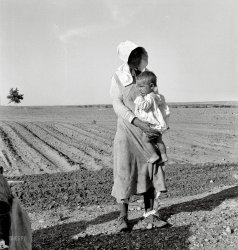
- End of the Road: 1935
- ... View full size. Medium-format nitrate negative by Dorothea Lange for the Resettlement Administration.
Perspective When I look at ... Posted by Dave - 06/28/2008 - 9:30am -
![End of the Road: 1935 June 1935. "Children of Oklahoma drought refugees on highway near Bakersfield, California. Family of six; no shelter, no food, no money and almost no gasoline. The child has bone tuberculosis." View full size. Medium-format nitrate negative by Dorothea Lange for the Resettlement Administration.
PerspectiveWhen I look at this photo as a history buff, it's so sad and poignant and so succinctly conveys the hard times of The Dust Bowl...and I say a silent word of thanks for photographers like Lange.
But when I look it as a mother, I am shaken at how desperately *afraid* these parents must have been--seriously, sickeningly, scared of how they would feed these children and what the future held for this precarious little family during this nation's Hard Times. (And I always wonder if Ms. Lange parted with some hard candy for the urchins in the picture or slipped a few dollars to the father when no one was looking...)
The 1930sI lived through the Depression. I thought I had it rough because my new Sears mail order shoes would come a week after school started and would be asked why I did not wear new shoes the first day of school. Seeing this family I now know what rough is. I do pray they got to California and their life improved.
Another "Okie"As a resident of Oklahoma now and lived here in my youth, I am amazed how ANY down-and-out person was from "Oklahoma" in all pitiful migrant photos from the 1930's. I have always wondered how 5 million "Okies" moved from Oklahoma which had barely over one million residents. Fascinating--maybe they subdivided on the way west...
[The population of Oklahoma in 1930 was 2.405 million; 10 years later it was 2.336 million, a loss of 69,000 people. Nobody is claiming that 5 million Oklahomans moved to California. - Dave]
AnklesThe smaller little girl appears to have some joint issues as well, alas, given the appearance of her ankles.
I guess this is one story's end we will probably never know. But whatever happened, at least they are not lost to history.
(Dorothea Lange, Kids, On the Road)](https://www.shorpy.com/files/images/8e03003u_0.thumbnail.jpg)
- Skid Row: 1937
- ... Modesto, California." Medium-format nitrate negative by Dorothea Lange for the Resettlement Administration. View full size.
The Bowery ... Posted by Dave - 11/29/2009 - 9:59am -
![Skid Row: 1937 March 1937. "Men on 'Skid Row.' Modesto, California." Medium-format nitrate negative by Dorothea Lange for the Resettlement Administration. View full size.
The BoweryThe NYC Skid Row was the Bowery, essentially the southern (downtown) end of Third Avenue. To this day it attracts guys and some women that are down on their luck. It is however, like many parts of the big cities, being gentrified. Expensive condo apartment houses were built, a few are being built and others planned. The ailing economy slowed it down but it still manages to survive. The Modesto inhabitants look much cleaner and better groomed than the Bowery flophouse denizens -- mainly drunks, junkies and mentally ill people. Ms. Lange's 1937 subjects look like university faculty members compared to the Bowery people of the 1940s and '50s that I remember.
ContrastsI can't help but notice the men may be on Skid Row, but are still neatly dressed as possible. The couple in the car passing at right seems to be studiously ignoring them. Finally, I presume the sign across the street says Turner Hardware and -- but can't conclude what the last word might be.
["Hardware & Implement Co." - Dave]
Turner Hardware and Implement Co.The building is still there, and has been renovated into a rather attractive office complex. Not skid row any more!
And today ...Same building, I believe:
View Larger Map
I always get double enjoyment ...from pictures from 1937 since I was born in August that year. I picture my mother as a pregnant young woman living in those times.
Turner Hardware todayhttp://reedproperties.net/index.php?album=the-turner-building-located-at...
(The Gallery, Cars, Trucks, Buses, Dorothea Lange, Great Depression)](https://www.shorpy.com/files/images/8b31835u.thumbnail.jpg)
- Currin Grocery: 1939
- ... combustibles and comestibles. Medium format negative by Dorothea Lange. View full size.
The empties sleep outside The empty bottle ... Posted by Dave - 08/21/2014 - 8:55am -
![Currin Grocery: 1939 July 1939. Granville County, N.C. "Country filling station owned and operated by tobacco farmer." Our second look at this establishment offering combustibles and comestibles. Medium format negative by Dorothea Lange. View full size.
The empties sleep outsideThe empty bottle returns are stacked outside in front of the building, a practice that still goes on at the small general store at the village near my summer cottage in the middle of nowhere.
Some things truly never change!
QuestionThese buildings were simply built on piles of bricks and not really anchored into the ground? Were they connected to the bricks somehow?
[Yes. By gravity. - Dave]
Bonnie & ClydeLooks like the place they picked up C.W. Moss in the 1967 film.
Cola WarsLooks like Coca Cola was the leading cola force in N.C. with this past series of photos, but RC Cola was definitely coming on strong.
Pepsi is nonexistent. I suppose it was still more of a Northern thing at the time.
BricksI live in the deep South (rural upstate South Carolina). putting buildings on bricks is still a very common practice. These days it's usually a pre-fab storage building or an old double-wide, but bricks are still the order of the day.
Found the shopkeeperLucius Aaron Currin, born 1879, died 1958, husband of Lelia Bobbitt, and father of at least three sons (all of who appear in the WWII draft records).
They were buried in Creedmoor, NC.
http://www.findagrave.com/cgi-bin/fg.cgi?page=gr&GRid=21348686
The original C-storesI grew up in rural South Carolina. These stores were quite common, and as a kid you were lucky if you lived within walking distance of one. You could spend your meager allowance there, visit with friends and check out the travelers that stopped for a cold drink and a fill up.
I left SC for good in 1963, and up until then all of the houses that I lived in were built on brick pillars.
The H C on the Sinclair Oil pump stands for High Compression or high octane.
Cola Wars responseActually, Pepsi is a North Carolina creation. Invented in 1898 in New Bern, NC.
Looks like homeI was born in 1939 (same year of this photo) in a store that looked like this; Except it was in WVa. My dad worked in an orchard. My mother worked in the store/post office,pumped gas,etc. in exchange for a room in the rear for us to live. We used the neighbor's outhouse across the road. We left there when WWII started and my dad got a job in an aircraft factory.
The swingThis is an upgrade from the usual bench or old sofa. I'm surprised it isn't occupied. Missing: bucket o' sticks for whittlin'.
Re: Cola WarsNo Pepsi advertisements as mentioned by skylark68. Pretty ironic, considering North Carolina is the birthplace of Pepsi.
Sinclair gasolineThe H-C on the Sinclair pump stands for Houston Concentrate. The H-C was Sinclair's "regular" gas grade at the time.
1920s-1930sHi, I have some strange questions related to the picture. Is anyone aware of other areas in the country where gas stations where built off the ground like this and on dirt roads like this? Are homes in the area from this time period also off the ground like this? Were these homes 1 story with only one small bedroom? Would an African American woman been able to work in the evening at a place like this? My questions are super strange but any insite is greatly appreciated. You can email me at Randi0411@yahoo.com or just reply on here. Thank you!!
(The Gallery, Dorothea Lange, Gas Stations, Stores & Markets)](https://www.shorpy.com/files/images/SHORPY-8b34207a1.thumbnail.jpg)
- Person County: 1939
- ... County, North Carolina. View full size. Photograph by Dorothea Lange.
Very serious worker.
I dig Very serious worker.
I dig his toes. ... Posted by Dave - 09/05/2012 - 2:56pm -
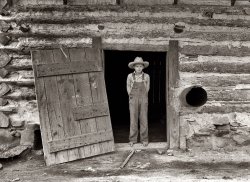
- Dust Bowl Farm: 1938
- ... here have been abandoned. View full size. Photo by Dorothea Lange.
Dust Bowl farmhouse I find it strange that I find this a ... Posted by Dave - 07/30/2012 - 2:39pm -
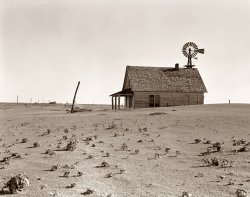
- Bosque Farms Baby: 1935
- ... shows temporary dwelling." Medium-format negative by Dorothea Lange for the Resettlement Administration. View full size.
Holy Mother ... Posted by Dave - 12/27/2012 - 10:33am -
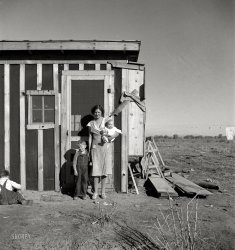
- Shacktown Kids: 1939
- ... wages, $44 per month. View full size. Photograph by Dorothea Lange.
An interesting comparison That figure of $44 per month, according ... Posted by Dave - 09/07/2011 - 9:56pm -

- The Good Earth: 1937
- ... managerial capacity." Medium-format nitrate negative by Dorothea Lange for the Farm Security Administration. View full size.
Field ... Posted by Dave - 07/30/2012 - 2:45pm -
![The Good Earth: 1937 June 1937. "Wife of Texas tenant farmer. The wide lands of the Texas Panhandle are typically operated by white tenant farmers, i.e., those who possess teams and tools and some managerial capacity." Medium-format nitrate negative by Dorothea Lange for the Farm Security Administration. View full size.
Field FashionI believe a scythe would be the more appropriate accessory for this
outfit. I guess I'll have to wait for October.
No RelationIs there a Mrs. Grim Reaper?
Plains JaneThis is a remarkable image. A solitary figure (Dad and team notwithstanding) in a forbidding landscape, with an agricultural implement only slightly more sophisticated than a stick. It helps illumine the enormity of the task which literally thousands of our forebears faced and leaves one wondering, "How did they do it?"
Up at dawnLooks like she has a long day ahead of her.
Bonnet and HoeReminds me of my grandparents. Gramma would make up a dozen or more bonnets each winter for her and my aunts to wear while working outside. She used flour sacks for the fabric. Notice the hoe handle is extra long. Grandpa would always whittle out hoe handles that would be at least 6 feet long. Much easier on the back. Fond memories now, but hard sweaty work back in the '60s.
Now I knowWhat they mean by the phrase "dirt farmer"
SodbusterI see what looks like a mule team near the horizon. I guess the woman is finishing the job that they started. Sometimes when I see a mule I wonder how the first guy decided to try mating a horse with a donkey to get that result. Or was it just an accidental discovery. Since mules cannot reproduce, horses and donkeys had to get together a lot in the old days.
Help pleaseThere is a famous painting that is very similar to this, I had a poster of it in my room as a child. Can anyone help me with the name of that painting or artist?
Spas, gyms and tanning parlorsThis hard-working industrious woman would need a very convincing argument to pay a membership fee to any of those establishments.
re: Help PleaseIs this it?
Woman with a Rake
Jean-François Millet c. 1856-7
The bee's kneesThank you so much Dave. I can not tell you how important that painting was for me. Now I know where to find a print. Again Thank you!
[Thank tterrace! - Dave]
(The Gallery, Agriculture, Dorothea Lange)](https://www.shorpy.com/files/images/8b31982u.thumbnail.jpg)
- Crossroads: 1939
- ... View full size. Medium-format nitrate negative by Dorothea Lange.
Box numbers Interesting that the mailboxes have box numbers ... Posted by Dave - 07/24/2012 - 7:06pm -
![Crossroads: 1939 October 1939. "Crossroads off the highway in a cut-over area. Boundary County, Idaho." View full size. Medium-format nitrate negative by Dorothea Lange.
Box numbersInteresting that the mailboxes have box numbers rather than addresses. I guess they're the equivalent of post office boxes, except they're not in a post office.
[Rural delivery addresses were usually box numbers combined with a route number. The farm I grew up on in Florida in the 1970s was Route 1, Box 66. - Dave]
Rural RoutesMy parents still have a Rural Route x, Box y address just outside of Birmingham, Alabama. Apparently the Post Office is doing away with it, though.
RR & BoxWe had a Rural Route prior to purchasing our new house. Still don't have home delivery and have to drive to the Post Office to retrieve our mail here in PA.
The scene above reminds me of the 'highlands' of Colorado just outside of Pubelo.
Rural Routes going awayIt is becoming more and more unusual to see Rural Route addresses in most places; when 911 became more common all addresses had to be changed to something physical. Typically the Post Office and some sort of regional planning council made the address changes.
[Our "Route 1, Box 66" got changed to "4397 154th Terrace." Bleh. - Dave]
Rural RoutesStill have rural delivery here in Missouri. But the weekend vandals enjoy bashing our mailboxes so it may not last much longer.
KFOGDave - You're the morning guy on KFOG, right? I think so....
[Um, no. - Dave]
CountiesI live in Kootenai, about thirty minutes away from Boundary. It's so very interesting to see a local picture, especially one taken by the talented Dorothea Lange! Thank you very much for posting it!
(The Gallery, Dorothea Lange, Rural America)](https://www.shorpy.com/files/images/8b35434u.thumbnail.jpg)
- Knee Baby: 1939
- ... the "knee baby." View full size. Photograph by Dorothea Lange.
Clean Poor but clean.
I was looking in the pic for I was ... Posted by Dave - 05/16/2012 - 7:11pm -
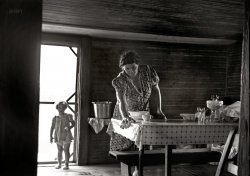
- Multimillionaire: 1936
- ... Valley, California." Medium-format nitrate negative by Dorothea Lange for the FSA. View full size.
Algodón Excelente. Vaya con ... Posted by Dave - 03/13/2008 - 6:20pm -
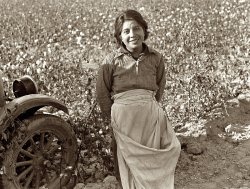
- Desert Guns: 1937
- ... Desert Guns and The Singing Vagabond . Photo by Dorothea Lange, Farm Security Administration. View full size.
Decisions, ... get any better than this.
(The Gallery, Bicycles, Dorothea Lange, Movies, OKC) ... Posted by Dave - 05/04/2018 - 11:30am -
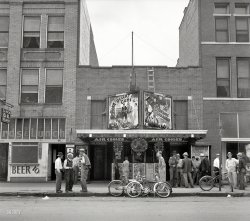
- Caroline's Kitchen: 1939
- ... View full size. Medium-format nitrate negative by Dorothea Lange for the Farm Security Administration.
sleep Don't forget to go to ... Posted by Dave - 07/30/2012 - 2:42pm -
![Caroline's Kitchen: 1939 July 1939. Caroline Atwater standing in the kitchen door of her log house. Orange County, North Carolina. View full size. Medium-format nitrate negative by Dorothea Lange for the Farm Security Administration.
sleepDon't forget to go to bed every now and then!
Thanks for the great job you do at Shorpy (day & night), and your nice comments!
How is it possible that all your pictures have such a great resolution? If I Google around and come at several places about American history I will find (quite often) the same picture as you deliver us, but never at such a resolution.
Pure magic! Could you reveal the secret behind that?
[The original photographs don't lack for resolution. In fact the large-format cameras of 100 years ago generated higher resolution photographs than 35mm film and today's digital SLRs. The secret is taking the time to work with the high-resolution scans in Photoshop to pull out the details - Ken]
Caroline's KitchenThis photograph is just plain exquisite. Shorpy has an embarrassment of pictorial riches, but even in such estimable company, this is a standout.
I am veering far too close to obsequious gushing, so let me just say once again, "Great job, guys!"
Aunt CarolineI want to go inside and have a cuppa cawfee with Aunt Caroline. And listen to her reminisce about when she was a girl.
digitalI think you have to consider that Lange was almost invariably using a view camera. Most digital cameras are 35mm or less. Large format can be had for many thousands of dollars. Digital images are every bit as sharp as those of Lange's time - if you know how to develop them.
It almost makes me cryLooking at the detail in her dress, the wood - everything makes it so clear how much we are losing right now in this stage of digital photography. I look at the photos here daily and I sometimes feel sad that although digital has brought us an explosion of photographs - it lacks the richness of a photo like this.
Photo qualityThanks Ken, I read the whole story about your way to improve the quality at the "Jailhouse Rock: 1941" photograph
https://www.shorpy.com/jailhouse-rock#comments
great work from you guys (at least I found a name new to me: Ken, most of the time I see Dave!).
[I notice that Ken hes changed his name to "Lexybeast", is that correct? - Alex, March 27, 2020
(The Gallery, Dorothea Lange, Rural America)](https://www.shorpy.com/files/images/8b33913u1.thumbnail.jpg)
- Union Man: 1938
- ... Union headquarters." Medium-format nitrate negative by Dorothea Lange for the Farm Security Administration. View full size.
Handsome ... Posted by Dave - 09/12/2009 - 4:21am -
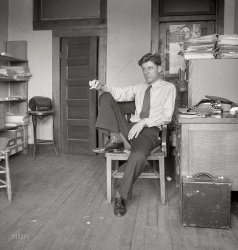
- Dazey Boy: 1939
- ... Malheur County, Oregon." Medium-format nitrate negative by Dorothea Lange for the Farm Security Administration. View full size.
Styles come ... Posted by Dave - 09/05/2012 - 7:10pm -
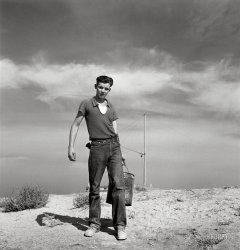
- Fix-a-Flat: 1937
- ... tire repairs along California highway U.S. 99." Photo by Dorothea Lange for the Farm Security Administration. View full size.
Chevy? ... Posted by Dave - 01/27/2015 - 8:49pm -
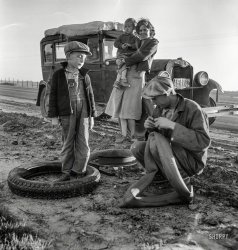
- Elm Grove: 1936
- ... known as Hoovervilles. Medium-format negative by Dorothea Lange. View full size.
This land is your land But this land is now ... Posted by Dave - 09/22/2012 - 2:20pm -
![Elm Grove: 1936 August 1936. "People living in miserable poverty. Elm Grove, Oklahoma County, Oklahoma." A good (or bad) example of the Depression-era shantytowns known as Hoovervilles. Medium-format negative by Dorothea Lange. View full size.
This land is your landBut this land is now likely under the Grand Lake o' the Cherokees.
Oklahoma Has Nothing On UsOur Depression story consists of this Hooverville photo, on the Great Lawn in Central Park, during the winter of 1932, with the Skyline of luxurious Central Park West in the background.
Family historyAssuming that there are descendents of these families, what did they tell their children, grandchildren, or even great-grandchildren about this period of time in their family's life? Do the great-grandchildren of former Hooverville inhabitants even know about their former residences? Some families would probably never talk about "the bad old days," and their own grandchildren wouldn't even know why their great-grandparents are buried in Oklahoma, while they live in California.
Temperature 115 degreesThis past summer was the hottest in Oklahoma's recorded history which made the news because it even exceeded the heat of that summer of 1936. Also this year, as then, it was a summer of severe drought. These people, unlike today, had no a/c, no fans, no showers, no electricity, no bottled water and not a lake in sight. It is a miracle that people could have lived through these conditions, especially combined with the grinding poverty of the dust bowl and I cannot help but marvel at their endurance and perseverance under such a hostile climate.
Chez NehiThat Nehi soda sign on the side of the building in today's collector's market would be worth $400 or more. If they only knew.
Elm Grove WIMy hometown is a bit more prosperous.
Photo flipped?Unless Nehi is spelled IHEN.
[The photo isn't backwards; the sign is upside-down. - tterrace]
Doh! I see that now, I also see the other writing is correct.
Not near Grand Lake, butIt is just over a mile away from downtown Oklahoma City, where you could now see in the background a skyscraper which is just under 800 feet tall, plus a number of other skyscrapers.
LaundrySince there is laundry hanging out to dry, and since these people are at least alive, they had some water source. Maybe that house in the distance had a well for livestock which they were allowed to use, or let them haul water from the house's own well.
My dadlived in a shanty like this, the youngest of eighteen kids (same mom!). It goes without saying that they had very little. People had very, very little during these times. My dad is STILL a tough old bird!
(The Gallery, Dorothea Lange, Great Depression)](https://www.shorpy.com/files/images/SHORPY_8b29748a.thumbnail.jpg)
- Americus: 1937
- ... near Americus, Georgia." Medium-format nitrate negative by Dorothea Lange. View full size.
Brings back memories. That boy looks like ... Posted by Dave - 07/25/2012 - 6:52pm -
![Americus: 1937 July 1937. "Thirteen-year old sharecropper boy near Americus, Georgia." Medium-format nitrate negative by Dorothea Lange. View full size.
Brings back memories.That boy looks like my brother Bill.
PlowboyHis clothes are falling off, but he looks so proud. Great picture.
A powerful photoSeventeen in 1941, I wonder if this boy would or could have enlisted. It looks like he's been working that plow for quite some years, and would be ready to move on, given any sort of chance; though he was possibly the family breadwinner.
There is nothing to sayJust look into that face.
My grandfather used a plow like this.He was so young, the handles would smack him in the head if he hit a rock. Think about that.
PovertyDave, this comment isn't really meant to be posted, but I want to thank you for not posting every comment that's submitted. As I'm sure you've found by now, just a simple photograph of a young black sharecropper will bring all sorts of racist comments. And who needs that?
[No such comments for this photo. - Dave]
Thanks for the great blog. It's one of my favorites. By the way, I'm live in New Orleans, so I especially enjoy the pictures of old New Orleans.
Is it 100% realCertain aspects of the clothes, appearance of the subject, the pose, all these items together just make me feel this is a fabricated picture. They did do those things even back then.
[Click here, take a look at the 5,000 or so photos in this series and judge for yourself. - Dave]
Hard workMy grandfather used to tell tales of walking all day behind one of these bottom plows, all day, one row at the time. There are still very many of these one-row plows stored away and forgotten sitting under barns all over Georgia to this day.
Today we have air conditioned cabs and 10+ row plows that can do in less than an hour what it would probably take this boy the better part of a week to do.
From what I can make out it looks like cotton he's plowing.
(The Gallery, Agriculture, Dorothea Lange)](https://www.shorpy.com/files/images/8b32269u.thumbnail.jpg)
- Louisiana: 1937
- ... size. Medium-format nitrate negative and caption by Dorothea Lange for the Farm Security Administration.
La. Woman I love her hat and ... Posted by Dave - 05/08/2013 - 11:12am -
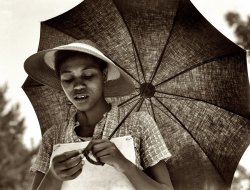
- Feeling Low in Toppenish: 1939
- ... in Washington State. Medium format nitrate negative by Dorothea Lange for the FSA. View full size.
Under the Weather Hope it wasn't ... Posted by Dave - 09/09/2011 - 11:34am -
![Feeling Low in Toppenish: 1939 August 1939. "Sick migrant child. Washington, Yakima Valley, Toppenish." The daughter of migrant laborers harvesting hops in Washington State. Medium format nitrate negative by Dorothea Lange for the FSA. View full size.
Under the WeatherHope it wasn't serious. She sure isn't faking!
I wonderDo you think she's still around?
[Paging Joe Manning ... - Dave]
Toppenish TodayToppenish today is still a small town, generally poor, still dependent on migrant workers for much of the harvest. However, the town also boasts a large number of murals painted on buildings depicting pioneer days, a highly-regarded small college, and a casino.
She Reminds Meof the little girl in the movie "Paper Moon"!
It's Addie Pray!Yes, definitely looks like Tatum O'Neil as Addie Pray in the film Paper Moon. One has to wonder if the films producers somehow saw this photograph. Highly doubtful, but the resemblance is uncanny.
(The Gallery, Dorothea Lange, Kids, Rural America)](https://www.shorpy.com/files/images/8b34329u1_0.thumbnail.jpg)
- Wapato Ennui: 1939
- ... clients." August 1939. View full size. Photograph by Dorothea Lange.
Wow This is by far the most moving, beautiful photo I've seen in ... Posted by Dave - 07/05/2009 - 2:43am -
![Wapato Ennui: 1939 "Washington, Yakima Valley, near Wapato. One of Chris Adolph's younger children. Farm Security Administration Rehabilitation clients." August 1939. View full size. Photograph by Dorothea Lange.
WowThis is by far the most moving, beautiful photo I've seen in a long time. Thank you for posting it.
[And thank you for commenting it. Please spread the word! You might also like this one. - Dave]
I agree. This moving photoI agree. This moving photo is so sad. The girl in the picture looks so resigned to her fate.Likes she's already given in.
Yakima ValleyI'm going to ask my father about that settlement. He and my grandparents moved from Wisconsin to Yakima in '31.
Wapato girlThis photo appeared on the cover of the first edition of Dorothy Allison's "Bastard Out of Carolina."
Look at herThis child is gorgeous, look at her. There was no hair care, or skin care, or air conditioning....or much anything elsee.
(The Gallery, Dorothea Lange, Great Depression, Kids)](https://www.shorpy.com/files/images/8b34383u1.thumbnail.jpg)
- Good Coffee: 1937
- ... -- all your basic ines. As well as potted cacti. Photo by Dorothea Lange. View full size.
Re: Soft drink dispenser My grandfather's ... Posted by Dave - 06/18/2018 - 1:29pm -
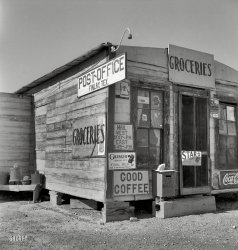
- Broke, Baby Sick: 1937
- ... the drought area. Broke, baby sick, car trouble." Photo by Dorothea Lange for the Farm Security Administration. View full size.
I hope I ... Posted by Dave - 06/12/2013 - 9:19pm -
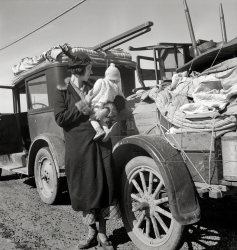
- The Comforts of Home: 1861
- ... unknown. This has a lot in common with the pictures Dorothea Lange would be taking 75 years later of Dust Bowl migrants in the agricultural ... Posted by Dave - 07/12/2014 - 2:18pm -
